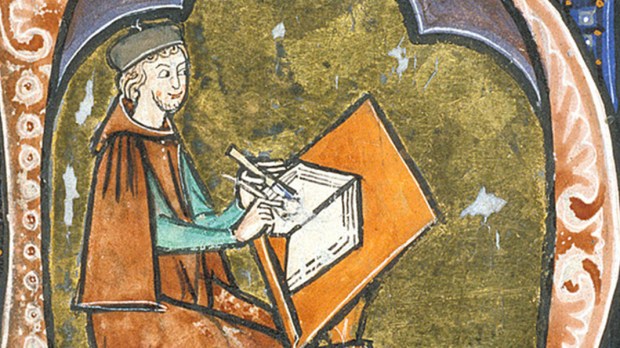There have been several articles in circulation recently about how medieval monks had a problem with distraction—just as people in the 21st century do (and they didn’t even have cell phones). The articles, which seem to be based on the work of Jamie Kreiner, who heads the history department at the University of Georgia, come across as medieval solutions for distraction in this, our digital age, when people seem to be getting less and less industrious because they’re too tempted to keep checking their social media accounts for the “latest.”
Apparently, some medieval thinkers recommended that people conjure up vivid images—including sexual ones–to ward off distraction while reading or praying. In particular, the 5th-century St. John Cassian is held up as someone who seemed to offer this solution for distraction.
“John Cassian, whose thoughts about thinking influenced centuries of monks, knew this problem all too well,” reads an article by Sam Haselby at Aeon, based on Kreiner’s work. “He complained that the mind ‘seems driven by random incursions.’ It ‘wanders around like it were drunk.’ It would think about something else while it prayed and sang. It would meander into its future plans or past regrets in the middle of its reading. It couldn’t even stay focused on its own entertainment—let alone the difficult ideas that called for serious concentration.”
Haselby said that medieval monks had solutions that “depended on imaginary pictures.”
Part of monastic education involved learning how to form cartoonish cognitive figures, to help sharpen one’s mnemonic and meditative skills. The mind loves stimuli such as color, gore, sex, violence, noise and wild gesticulations. The challenge was to accept its delights and preferences, in order to take advantage of them. Authors and artists might do some of the legwork here, by writing vivid narratives or sculpting grotesque figures that embodied the ideas they wanted to communicate. But if a nun wanted to really learn something she’d read or heard, she would do this work herself, by rendering the material as a series of bizarre animations in her mind. The weirder the mnemonic devices the better—strangeness would make them easier to retrieve, and more captivating to think with when she ‘returned’ to look them over.
But an expert on monks such as Cassian was taken aback by the theory.
“I am frankly surprised that anyone who has read Cassian could claim that [he] advocated the use of vivid imagery in prayer or ascetical practice,” said Fr. Luke Dysinger, a Benedictine monk who teaches at St. John’s Seminary in Camarillo, California. “In fact, Cassian encourages the opposite of what we would today call ‘guided imagery.’”
Cassian’s spiritual master and teacher, Evagrius Ponticus, emphasized the importance of “pure prayer,” Dysinger told Aleteia. By that “he meant what we today would called apophatic prayer or meditation: that is, prayer understood as simple attentiveness to God without the need for images or words. This was part of the legacy of Clement of Alexandria and especially of the controversial Origen, whose famous treatise on prayer was undoubtedly the source of Evagrius’ approach.”
Another expert, Fr. Cassian Folsom, was blunt in his reaction.
“I have no idea what this person is talking about, since St. John Cassian explicitly stresses image-less prayer,” said Fr. Folsom, a founder of the Monks of Norcia in Italy. “In all the strategies for dealing with the ‘thoughts’ or ‘logismoi’ or ‘vitia’ (both Cassian and Evagrius are masters here) there is nothing about imaginary pictures, or letting the imagination run riot, or anything of the sort.”
Dysinger points to Cassian’s work the Conferences, parts 9 and 10, in which he encourages pure prayer “free from all memories and distractions as well as ‘fiery prayer’ that begins with words but rises above them.
“In Conference 10.10 Cassian advocates the practice of monologistic meditation, the constant repetition of a brief biblical text, as a way of attaining this imageless prayer, the Benedictine said. “He introduces this practice by describing the ‘anthropomorphite controversy’ precipitated by Archbishop Theophilus of Alexandria, who insisted that one should not maintain a mental image of God while praying (Conf. 10.1-5). Cassian agrees with this and highlights the need to strive for
… that perfectly pure condition in prayer which will not only not connect with its prayers any figure of the Godhead or bodily lineaments (which it is a sin even to speak of), but will not even allow in itself even the memory of a name, or the appearance of an action, or an outline of any character. (Conf. 10.5.3)
Dysinger speculated that some authors may have been misled by Cassian’s sometimes-vivid descriptions of how the temptation of lust afflicts the soul, as in Institutes 6.10-12, “but here, too, he advocates ruthlessly suppressing such images and memories (Inst. 6.13).”
The priest said that while “guided imagery” is foundational to St. Ignatius’ of Loyola’s Spiritual Exercises, early monks such as Cassian had a “very different approach to prayer and meditation.”
When apprised of the two priests’ criticism of the supposed medieval solution for distraction, Kreiner explained, “Although Evagrius and Cassian advocated image-less prayer for advanced monks, the image-based techniques that I discuss in the Aeon piece were recommended … by theologians in the high and late Middle Ages, particularly as an aid for beginners. A convenient example that is available in translation is Thomas Bradwardine’s discussion translated in Carruthers and Ziolkowski’s Art of Memory. The mental images that Bradwardine recommends are marginally rather than overtly sexual: the point isn’t to imagine sex per se but to manipulate things that are memorable in order to put the mind to more productive uses.”
Kreiner insists that Cassian does suggest (in Collationes 15.10 and 19.16) that advanced monks could try imagining having sex with a woman to see if they become aroused. “This wasn’t a meditational technique, however: the exercise would instead test how much control a monk had over himself in that imaginary scenario.”

